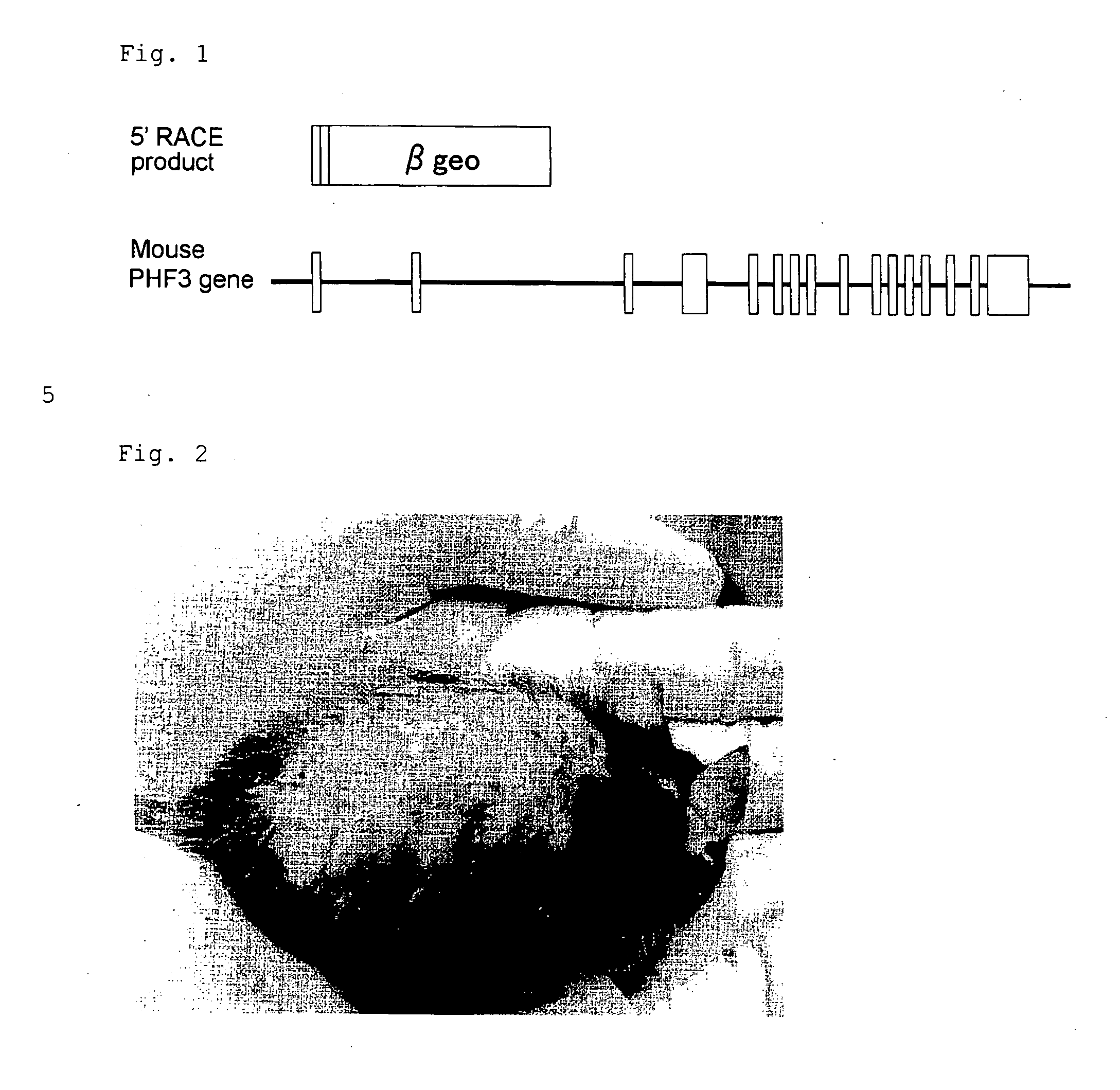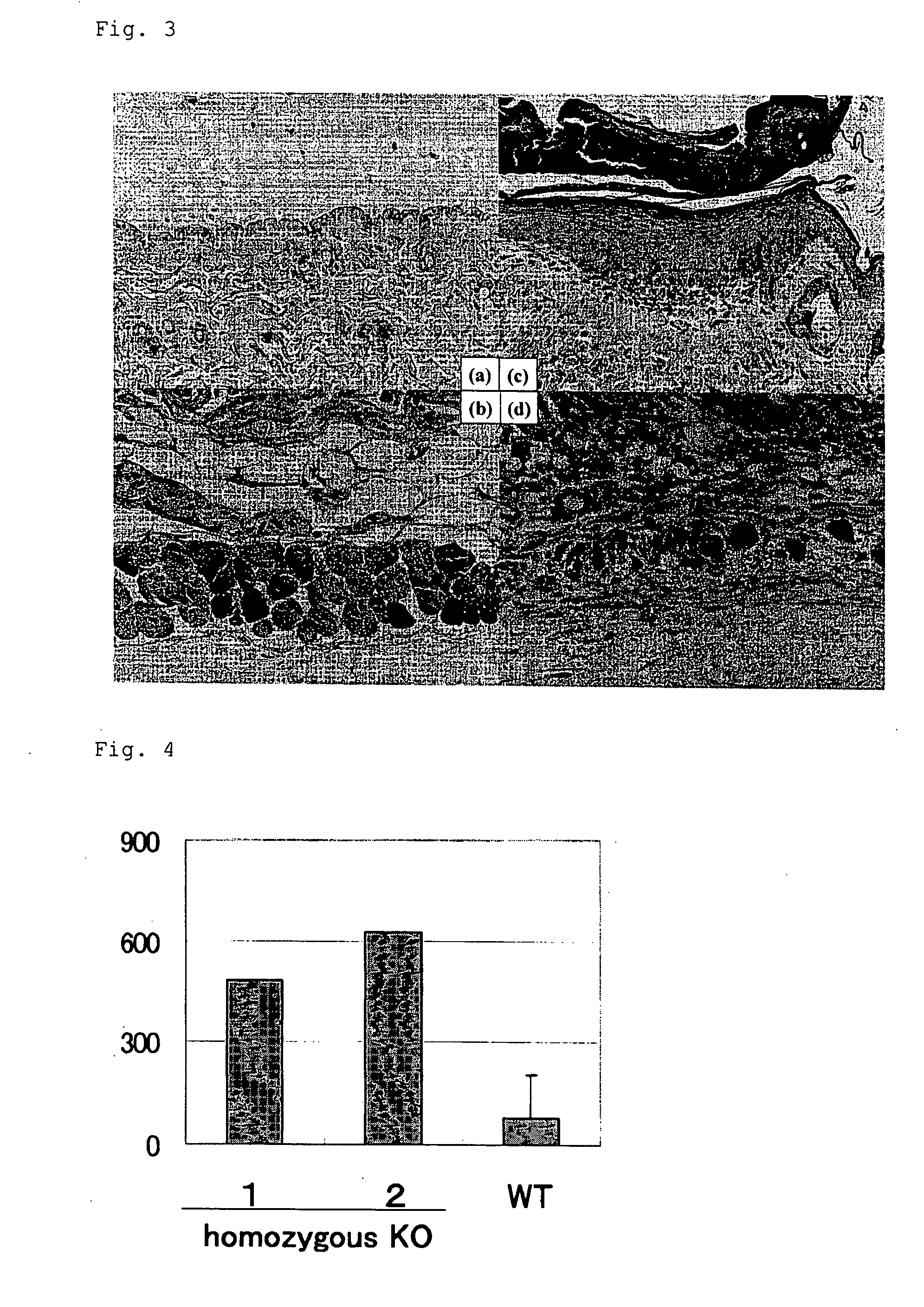Knockout Non-Human Animal
a non-human animal and knockout technology, applied in the field of knockout non-human animals, can solve the problem of failure of each organ via an immunoglobulin e-mediated inflammatory mechanism
- Summary
- Abstract
- Description
- Claims
- Application Information
AI Technical Summary
Benefits of technology
Problems solved by technology
Method used
Image
Examples
example 1
Preparation of PHF3 Gene Knockout ES Cell
[0235] PHF3 gene knockout ES cells were prepared by a gene trap method (International Publication WO01 / 005987) using a trap vector pU-17.
[0236] It was confirmed that a disrupted or recombined gene is only the PHF3 gene, according to the following method.
[0237] In the ES cell used, it was confirmed by PCR analysis that only a copy of the vector was introduced, and it was also confirmed by Southern blotting analysis that the full length of the vector was introduced. Further, when a partial sequence of the trapped gene (a cDNA sequence upstream of an insertion position of the trap vector) was determined by a 5′ RACE method, it was consistent with the nucleotide sequences of the first exon and the second exon of the PHF3 gene (GenBank Acc. No. XM—129836) (see FIG. 1). The mouse PHF3 gene is composed of 16 exons, and encodes a protein consisting of 2025 amino acids. A translation initiation codon of the gene is present in the second exon. In a ...
example 2
Production of PHF3 Gene Knockout Mouse
[0238] A chimeric mouse comprising cells in which the PHF3 gene was knocked out was produced according to the following method. The ES cell prepared in Example 1 in which the PHF3 gene was disrupted or recombined and an ICR line 8-cell stage embryo were aggregated by an aggregation method (Nagy A., 1993, Oxford University Press, Oxford, pp 147-179). On the following day, the chimeric embryo which had been developed into a morula or a blastocyst was transplanted into the uterus of a pseudo-pregnancy-induced ICR line female mouse (pseudo-pregnancy induction day 3) (Shinichi Aizawa: Gene targeting: Preparation of Mutated Mouse using ES Cell, Yodosha Co., Ltd, 1995). After 17.5 days from transplantation, the female mouse was subjected to caesarotomy to take out a fetal, and thereby a chimeric mouse was obtained.
[0239] The chimeric mouse was reared by a foster parent for 4 weeks (Shinichi Aizawa: Gene targeting: Preparation of Mutated Mouse using E...
example 3
Pathological Test of PHF3 Gene Homo-Knockout Mouse
[0242] The atopic dermatitis symptoms found in the PHF3 gene homo-knockout mouse produced in Example 2 were histopathologically tested according to the following method. After the 8 week-old PHF3 gene homo-knockout mouse was led to death by exsanguination under ether anesthesia, a part of a skin tissue (abdominal) was taken from the mouse and fixed in a 10% neutral buffered formalin solution at room temperature for 1 week. The fixed skin tissue was alcohol-dehydrated, then embedded in paraffin, and thinly sliced at a thickness of 2 to 10 um using a microslicer. The resulting thin section was placed on a slide glass. The thin section was de-paraffined (7 min×3) with xylene, washed with 100% ethanol (30 sec×1, 2 min×2) and then distilled water, and then stained with hematoxylin / eosin (hereinafter, referred to as HE staining). The HE staining was performed by immersing the section in a hematoxylin solution (a solution of hematoxylin 2 ...
PUM
| Property | Measurement | Unit |
|---|---|---|
| temperature | aaaaa | aaaaa |
| weight | aaaaa | aaaaa |
| weight | aaaaa | aaaaa |
Abstract
Description
Claims
Application Information
 Login to View More
Login to View More - R&D
- Intellectual Property
- Life Sciences
- Materials
- Tech Scout
- Unparalleled Data Quality
- Higher Quality Content
- 60% Fewer Hallucinations
Browse by: Latest US Patents, China's latest patents, Technical Efficacy Thesaurus, Application Domain, Technology Topic, Popular Technical Reports.
© 2025 PatSnap. All rights reserved.Legal|Privacy policy|Modern Slavery Act Transparency Statement|Sitemap|About US| Contact US: help@patsnap.com



